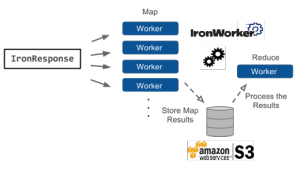Tutorials
Map-Reduce Capabilities and Super Easy Concurrency (via Alan deLevie and IronResponse)
We came across a great contribution the other day from Alan deLevie that makes using IronWorker for a map-reduce pattern even easier than it already is. (Love seeing tweets announcing additions to the growing list of Iron.io community addons.) I just wrote a gem that lets you write map-reduce style code using @getiron: https://t.co/49DNyLrXey. Makes…
Read MoreSendGrid + IronMQ: The Power of Webhook-Centric Architectures
A suite of examples showcasing the power of webhooks using Iron.io and SendGrid. At Iron.io, we believe strongly that there is a new model of application architectures that is becoming not only viable, but the most powerful way to build your application. More and more applications will be built not using static servers and direct integrations, but instead…
Read MoreWeb Crawling at Scale with Nokogiri and IronWorker (Part 2)
This is the second part of a two-part post on using IronWorker with Nokogiri to do web crawling at scale. The first blog post can be viewed here. Other resources for web crawling can be seen on our solutions page as well as this post on using IronWorker with PhantomJS.
Read MoreWeb Crawling at Scale with Nokogiri and IronWorker (Part 1)
This is a two-part post focusing on using Nokogiri and IronWorker to crawl websites and process web pages. Part two can be seen here. For other resources on web crawling, see our solutions page as well as this in-depth article on using IronWorker with PhantomJS. Web crawling is at the core of many web businesses.…
Read MoreServerless PhantomJS with IronWorker
PhantomJS is a headless WebKit with Javascript API. From it’s website, “It has fast and native support for various web standards: DOM handling, CSS selector, JSON, Canvas, and SVG.” In other words, PhantomJS is a great solution for things like web crawling/scraping, headless website testing, etc. The perfect match for IronWorker.
Read MorePowerful Email Infrastructure with IronWorker, ActionMailer, and SendGrid
Against most predictions, email has stood the test of time and remains one of the most common and effective forms of communication. This is particularly true in the world of web applications where the flow of information from app to user is constant. Ruby on Rails is one of the leading stack choices for building…
Read MoreSpikability – An Application’s Ability to Handle Unknown and/or Inconsistent Load
Neo Handling Load I’ve been in many conversations recently about how an application can handle spiky behavior. More importantly, how to handle it without a bunch of wasted resources that sit idle most of the time just to handle the spikes. There are a bunch of applications where this is a very typical use case, for instance:
Read MoreBest Practices: Scalable Image Processing
They say a picture is worth a thousand words. Coincidentally, processing an image is about a thousand times more demanding than processing text. As more and more developers look to image processing solutions like ImageMagick to power social, retail, and mobile apps, they will run into many challenges as they try to get it to…
Read MoreOne Webhook to Rule Them All – One URL, Millions of Possibilities
Have you ever wished the service you were using had integrations with other third party services? If it supports webhooks, I’ll show you in this post how to easily integrate with any service that has an API. And no server is required. What is a Webhook? “The concept of a WebHook is simple. A WebHook…
Read MoreVideo Series – Episode 2: Scheduling
Hey All, Here’s the second video in my tutorial series. In under 3 minutes I demonstrate how to schedule a worker that posts to Twitter, and even show the code involved, which is a grand total of about 50 lines.
Read More

